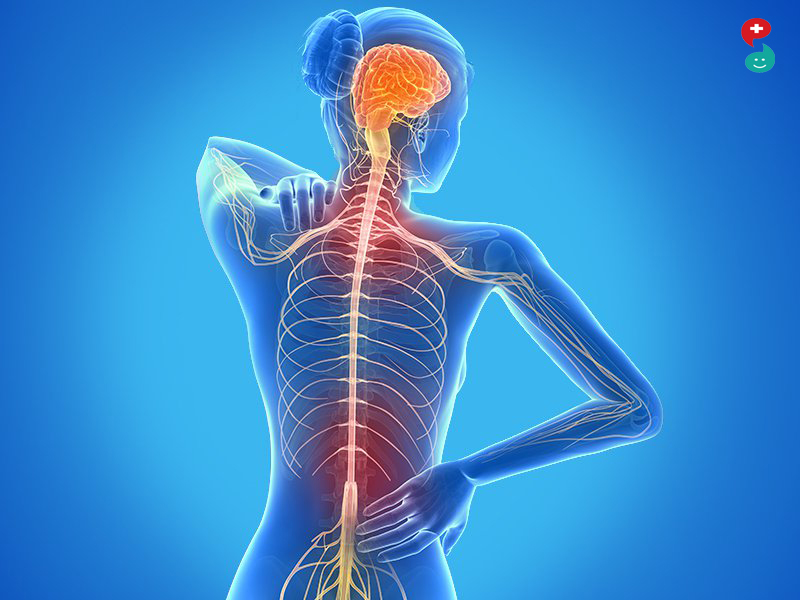Exam Overview
Before conducting a neurological examination for multiple sclerosis (MS), the doctor will collect information about your symptoms. The kinds of symptoms, as well as how and when they occur, are important in evaluating whether you might have MS. Even symptoms that you might have had several years ago can be important.
The neurological examination will cover both how well you think and how well you move.
Mental ability and emotional condition
The doctor may ask you to repeat a series of numbers or answer simple questions about dates, places, and current events. The doctor can usually judge your emotional condition during the exam by paying attention to your actions and statements.
If the doctor suspects mental problems caused by multiple sclerosis (MS), he or she may order tests designed to identify more subtle changes than the ones that may be evident from the brief mental section of the neurological examination.
Coordination, strength, senses, and reflexes
The doctor will look for injury to the 12 pairs of nerves in the head (cranial nerves) that relate to:
Sense of smell.
Sense of taste.
Vision.
Eye movement.
Sensation in the face and scalp.
Muscle coordination in the face and neck.
Hearing and balance.
Swallowing and the gag reflex.
Movement of the tongue.
To evaluate muscle strength, the doctor will have you push with the arms and legs against the doctor's hand. Dexterity, muscle tone, and muscle control will also be tested.
You will be examined for the ability to:
Feel pain (a pinprick), a light touch, temperature, and vibration (a tuning fork).
Sense the position of the arms or legs.
Also, your reflexes will be tested.
The neurological history and examination may take as long as 2 hours but usually take 1 hour or less.
Why It Is Done
A brief neurological examination is part of any complete physical exam. If you report symptoms that suggest a problem with the nervous system, the doctor may do a more thorough neurological exam. Such an exam will always be done if you have symptoms that suggest MS.
Results
Findings on the neurological exam may include the following.
Normal
All tested functions are within normal ranges.
Abnormal
Abnormal findings may include evidence of nervous system abnormalities, such as weakness, blindness, coordination or balance problems, or changes in sensation.
What To Think About
Because MS lesions (injured or inflamed nerve tissues) may be found in several locations on the brain and spinal cord, symptoms can vary greatly. Some lesions may not cause signs or symptoms that the doctor can evaluate during an exam. Other tests may be needed to help make the diagnosis, especially when there is a history of several attacks.
Multiple sclerosis (MS) is a condition that can affect the brain and/or spinal cord, causing a wide range of potential symptoms, including problems with vision, arm or leg movement, sensation or balance.
It's a lifelong condition that can sometimes cause serious disability, although it can occasionally be mild.
In many cases, it's possible to treat symptoms. Average life expectancy is slightly reduced for people with MS.
It's estimated that there are around 127,000 people diagnosed with MS in the UK.
It's most commonly diagnosed in people in their 20s and 30s, although it can develop at any age. It's about 2 to 3 times more common in women than men.
Symptoms of MS
The symptoms of MS vary widely from person to person and can affect any part of the body.
The main symptoms include:
fatigue
difficulty walking
vision problems, such as blurred vision
problems controlling the bladder
numbness or tingling in different parts of the body
muscle stiffness and spasms
problems with balance and co-ordination
problems with thinking, learning and planning
Depending on the type of MS you have, your symptoms may come and go in phases or get steadily worse over time (progress).
Read more about the symptoms of MS.
Getting medical advice
See your GP if you're worried you might have early signs of MS. The early symptoms often have many other causes, so they're not necessarily a sign of MS.
Let your GP know about the specific pattern of symptoms you're experiencing.
If you GP thinks you could have MS, you'll be referred to a neurologist (a specialist in conditions of the nervous system), who may suggest tests such as an MRI scan to check for features of MS.
Read more about diagnosing MS.
Types of MS
MS starts in 1 of 2 general ways: with individual relapses (attacks or exacerbations) or with gradual progression.
Relapsing remitting MS
More than 8 out of every 10 people with MS are diagnosed with the relapsing remitting type.
Someone with relapsing remitting MS will have episodes of new or worsening symptoms, known as relapses.
These typically worsen over a few days, last for days to weeks to months, then slowly improve over a similar time period.
Relapses often occur without warning, but are sometimes associated with a period of illness or stress.
The symptoms of a relapse may disappear altogether, with or without treatment, although some symptoms often persist, with repeated attacks happening over several years.
Periods between attacks are known as periods of remission. These can last for years at a time.
After many years (usually decades), many, but not all, people with relapsing remitting MS go on to develop secondary progressive MS.
In this type of MS, symptoms gradually worsen over time without obvious attacks. Some people continue to have infrequent relapses during this stage.
Around half of people with relapsing remitting MS will develop secondary progressive MS within 15 to 20 years, and the risk of this happening increases the longer you have the condition.
Primary progressive MS
Just over 1 in 10 people with the condition start their MS with a gradual worsening of symptoms.
In primary progressive MS, symptoms gradually worsen and accumulate over several years, and there are no periods of remission, though people often have periods where their condition appears to stabilise.
What causes MS?
MS is an autoimmune condition. This is when something goes wrong with the immune system and it mistakenly attacks a healthy part of the body – in this case, the brain or spinal cord of the nervous system.
In MS the immune system attacks the layer that surrounds and protects the nerves, called the myelin sheath.
This damages and scars the sheath, and potentially the underlying nerves, meaning that messages travelling along the nerves become slowed or disrupted.
Exactly what causes the immune system to act in this way is unclear, but most experts think a combination of genetic and environmental factors is involved.
Read more about the causes of MS.
Treatments for MS
There's currently no cure for MS, but a number of treatments can help control the condition.
The treatment you need will depend on the specific symptoms and difficulties you have.
It may include:
treating relapses with short courses of steroid medication to speed up recovery
specific treatments for individual MS symptoms
treatment to reduce the number of relapses, using medicines called disease-modifying therapies
Disease-modifying therapies may also help to slow or reduce the overall worsening of disability in people with relapsing remitting MS, and in those with secondary progressive MS still having relapses.
Unfortunately, there's currently no treatment that can slow the progress of primary progressive MS or secondary progressive MS in the absence of relapses.
एकाधिक स्क्लेरोसिस (एमएस) साठी न्यूरोलॉजिकल तपासणी करण्यापूर्वी, डॉक्टर आपल्या लक्षणेंबद्दल माहिती गोळा करेल. आपल्याकडे एमएस असू शकते किंवा नाही हे लक्षणांचे प्रकार तसेच ते कसे आणि कधी होतात हे महत्वाचे आहेत. आपण कदाचित अनेक वर्षांपूर्वी लक्षणे देखील महत्वाचे असू शकतात.
न्यूरोलॉजिकल परीक्षेत आपण किती चांगले विचार करता आणि आपण किती चांगले चालता हे दोन्ही समाविष्ट करेल.
मानसिक क्षमता आणि भावनिक स्थिती
तारखांची ठिकाणे, ठिकाणे आणि वर्तमान इव्हेंटबद्दल सामान्य संख्यांची संख्या किंवा सामान्य प्रश्नांची उत्तरे देण्यासाठी डॉक्टर आपल्याला विचारू शकतात. आपल्या कृती आणि विधानांवर लक्ष देऊन डॉक्टर आपल्या भावनात्मक स्थितीचे परीक्षेत सामान्यतः परीक्षण करू शकतात.
बहुविध स्क्लेरोसिस (एमएस) द्वारे झाल्याने मानसिक समस्या झाल्यास डॉक्टरांना संशय येत असेल तर, त्या न्यूरोलॉजिकल परीक्षणाच्या संक्षिप्त मानसिक विभागात दिसून येणाऱ्या सूक्ष्म बदलांची तुलना करण्यासाठी डिझाइन केलेल्या टेस्टची मागणी करू शकतात.
समन्वय, सामर्थ्य, इंद्रियां आणि प्रतिबिंब
डोकेमध्ये (कर्णगामी नस्या) 12 जोड्या नसलेल्या डॉक्टरांना दुखापत वाटेल:
गंध वास.
चव च्या भावना.
दृष्टी
डोळा हालचाल
चेहर्याचा आणि खोपडी मध्ये संवेदना.
चेहरा आणि मान मध्ये स्नायू समन्वय.
ऐकणे आणि शिल्लक
निगलणे आणि गोंधळ
जीभ चळवळ.
स्नायूंच्या ताकदांचे मूल्यांकन करण्यासाठी डॉक्टर आपल्या हाताने हात व पाय आपल्या डोक्यावर ठेवतील. निपुणता, स्नायू टोन आणि स्नायू नियंत्रण देखील तपासले जाईल.
आपणास याची क्षमता तपासली जाईल:
वेदना (एक पिनप्रिक), एक हलकी स्पर्श, तपमान आणि कंपन (एक टिंगिंग कांटा).
हात किंवा पायाची स्थिती समजून घ्या.
तसेच, आपल्या प्रतिबिंबांचे परीक्षण केले जाईल.
न्यूरोलॉजिकल इतिहासात आणि परीक्षेस 2 तास लागू शकतात परंतु सामान्यतः 1 तास किंवा त्यापेक्षा कमी वेळ लागू शकतात.
ते का झाले आहे
एक संक्षिप्त न्यूरोलॉजिकल परीक्षा कोणत्याही पूर्ण शारीरिक परीक्षा भाग आहे. जर आपण अशी लक्षणे नोंदवत असाल जी तंत्रिका तंत्रामध्ये समस्या दर्शवितात तर डॉक्टर अधिक न्यूरोलॉजिकल परीक्षा घेऊ शकतात. एमएस दर्शविणारी लक्षणे आपल्याकडे असल्यास अशा प्रकारचे परीक्षा नेहमीच केली जाईल.
परिणाम
न्यूरोलॉजिकल परीक्षेच्या निष्कर्षांमध्ये खालील गोष्टींचा समावेश असू शकतो.
सामान्य
सर्व चाचणी केलेले कार्य सामान्य श्रेणींमध्ये असतात.
असामान्य
असामान्य निष्कर्षांमध्ये नर्वस सिस्टम असामान्यता, जसे की कमजोरी, अंधत्व, समन्वय किंवा समतोल समस्येचे प्रमाण किंवा संवेदनात बदलांचा पुरावा समाविष्ट असू शकतो.
कशाबद्दल विचार करायला पाहिजे
कारण एमएस घाव (जखमी किंवा सूज असलेले ऊतक) मस्तिष्क आणि रीढ़ की हड्डीच्या अनेक ठिकाणी आढळू शकतात, लक्षणे मोठ्या प्रमाणात बदलू शकतात. काही जखमांना परीक्षेत डॉक्टर मूल्यांकन करू शकतील अशा चिन्हे किंवा लक्षणे दिसू शकत नाहीत. निदान करण्यात मदत करण्यासाठी इतर चाचण्यांची आवश्यकता असू शकते, विशेषत: जेव्हा अनेक हल्ल्यांचा इतिहास असेल.
मल्टिपल स्क्लेरोसिस
मल्टिपल स्क्लेरोसिस हा मज्जासंस्थेतील काठिण्यामुळे होणारा आजार आहे. त्यात मुख्य मज्जासंस्था अकार्यक्षम झाल्याने मेंदूमध्ये होणारे संदेशवहन आणि मेंदू-शरीरादरम्यान होणारे संदेशवहन विस्कळीत होते. मल्टिपल स्क्लेरोसिसने बाधित व्यक्तीमध्ये नसांच्या फायबरच्या संरक्षित आवरणावरच प्रतिकार क्षमता हल्ला करते आणि मेंदू आणि सर्व शरीर यांच्यातील संदेशवहनावर त्याचा परिणाम होतो. शेवटी मल्टिपल स्क्लेरोसिसमुळे नसा नष्ट होऊ लागतात किंवा नसांचे कायमचे नुकसान होते. तसेच मल्टिपल स्क्लेरोसिस मेंदू आणि मणक्यावर परिणाम करतो...
मल्टिपल स्क्लेरोसिसमध्ये सुरुवातीच्या काही लक्षणांमध्ये अशक्तपणा, बधीरपणा आणि अंधूक दृष्टी अशी लक्षणे दिसतात. इतर काही लक्षणांमध्ये स्नायूंचे आखडणे, विचारक्षमता कमी होणे आणि मूत्रमार्गाच्या समस्या भेडसावतात. ज्या व्यक्तींना मल्टिपल स्क्लेरोसिस होतो त्यांच्यात वयाच्या 20 ते 40 वर्षांदरम्यान सुरुवातीची काही लक्षणे दिसून येतात. या लक्षणांकडे दुर्लक्ष करू नका. जरी ही लक्षणे काही काळासाठी दूर होत असली, तरीही ती पुन्हा डोके वर काढू शकतात. या आजाराची काही सर्वसाधारण लक्षणे आहेत त्यात टोचल्यासारखे वाटणे, बधीरपणा, खाज सुटणे, जळजळ, तीव्र वेदना होणे ही दिसतात. या सर्व लक्षणांची दखल घेऊन त्यावर उपचार करता येतात. मूत्राशयाच्या समस्येत सर्वसाधारण व्यक्तीपेक्षा अधिकवेळा मूत्रप्रवृत्ती होते. तसे शौचविसर्जनाच्या समस्या निर्माण होतात आणि बद्धकोष्ठता होते. चालताना तोल जाऊ शकतो. कारण, मेंदू आणि मणका यांच्यातील संदेशवहन प्रभावित झालेले असते. याचाच अर्थ मल्टिपल स्क्लेरोसिसमुळे अशक्तपणा येतो, तसेच स्नायू आखडतात, त्यामुळे व्यक्तीला हालचाल करणे किंवा चालणे अवघड होऊन बसते. त्याव्यतिरिक्त तोल जाणे, पायात बधीरपणा, थकवा यामुळेही चालणे अवघड होते.
मल्टिपल स्क्लेरोसिसची कारणे :
याची नेमकी कारणे अजूनही ज्ञात नाहीत; पण संशोधनांमधून यासाठी काही अनुवांशिक घटक आणि पर्यावरणीय घटक सामील असल्याचे म्हटले आहे.
1) पर्यावरणीय घटक: स्कॉटलंड, स्कॅडीनिव्हिया आणि उत्तर युरोपात प्रामुख्याने हा आजार होतो. इतर वंशीय समाजापेक्षा श्वेतवर्णीय समाजात याचे प्रमाण अधिक असते. वयात येण्याअगोदरच विशिष्ट वातावरणाची सवय मल्टिपल स्क्लेरोसिससाठी पूर्वपरिस्थिती निर्माण करू शकते. काही अपवाद वगळता विषुववृत्तापासून दूर गेल्यास मल्टिपल स्क्लेरोसिसचा प्रसार अधिक प्रमाणात होतो.
2) अनुवांशिक घटक: कुटुंबातील पहिल्या, दुसर्या आणि तिसर्या पिढीतील नातेवाइकांमध्ये हा आजार असल्यास धोका बळावतो. भावंडांपैकी कोणाला हा आजार असल्यास दुसर्या भावंडाला होण्याची शक्यता 5 टक्क्यांनी वाढते. जुळ्या भावंडांमध्ये हा आजार होण्याची शक्यता 30 टक्क्यांनी वाढते. सर्वसाधारणपणे पालकांना हा आजार असल्यास ही शक्यता 10 पटींनी वाढते. काही अनुवांशिक घटकांमुळेही मल्टिपल स्क्लेरोसिस विकसित होण्याची शक्यता असते.
3) इतरही काही घटक मल्टिपल स्क्लेरोसिसचा विकास होण्यास कारणीभूत ठरतात : एपस्टेन-बर (मोनोन्युक्लिओसिस) व्हॅरिकेला झोस्टर यासारखे विषाणू आणि हेपटायटिसचे इंजेक्शन. गर्भावस्थेत इस्ट्रोजेन आणि प्रोजेस्टेरॉन लैंगिक संप्रेरकांमध्ये वाढ.
धूम्रपान.
तणाव.
या आजाराची लक्षणे व्यक्तिगणिक बदलतात आणि कोणत्या नर्व्ह फायबरवर परिणाम झाला आहे, त्यावर ही लक्षणे अवलंबून असतात. अर्थात, सुरुवातीची लक्षणे सारखी असतात. दृष्टीच्या समस्या आणि स्मरणशक्तीच्या समस्या ही प्राथमिक लक्षणे आहेत. इतर काही लक्षणे पाहूयात...
1) दृष्टीची समस्या वाढून कमी दिसणे किंवा दृष्टी पूर्णपणे जाणे. ही समस्या एकावेळी एकाच डोळ्याची भेडसावते. डोळ्यांची हालचाल करताना वेदना होतात.
2) दुहेरी दृष्टीचा त्रास.
3) एकावेळी शरीराच्या एका बाजूच्या अवयवांमध्ये अशक्तपणा येतो. त्यामुळे पायावर परिणाम होतो.
4) विशेषतः, जेव्हा मान पुढच्या बाजूला झुकवतो तेव्हा मानेपासून पाठीपर्यंत आणि अवयवांमध्ये विजेचा झटका लागल्याची जाणीव होते. या लक्षणाला लार्मिट लक्षणे म्हणतात.
5) असंतुलित चालण्यामुळे समन्वय राहत नाही.
6) अस्पष्ट बोलणे.
7) थकवा आणि चक्कर येणे.
8) शौचविसर्जन आणि मूत्राशय यांच्या समस्या.
या आजाराचा झटका येतो तेव्हा ही सर्व लक्षणे एकदम गायब होतात; पण स्नायूची समस्या कायम राहते आणि ती वाढत जाते.
अन्य लक्षणे :
1) थकवा आणि अशक्तपणा ः मल्टिपल स्क्लेरोसिसच्या 80 टक्के रुग्णांमध्ये सुरुवातीच्या टप्प्यात अचानक थकवा आणि अशक्तपणा जाणवतो. मणक्याच्या नसांचे जेव्हा नुकसान होऊ लागते तेव्हा खूप अधिक थकवा येतो. सर्वसाधारणपणे थकवा अचानक येतो आणि सुधारणा होण्याआधी खूप आठवडे तो तसाच राहतो. पायाचा शक्तिपात होणे ही अगदी सहज लक्षात येणारी गोष्ट आहे.
2) मोठे आतडे आणि मूत्राशय विकार : 80 टक्के रुग्णांमध्ये मूत्राशयाचे कार्य व्यवस्थित चालत नसल्याची लक्षणे दिसून येतात. त्यामुळे सतत लघवी होणे, लघवीला घाई होणे, लघवीवर नियंत्रण ठेवता न येणे अशा समस्या भेडसावतात. मूत्राशयाशी निगडित समस्यांवर नियंत्रण मिळवता येते. मल्टिपल स्क्लेरोसिसच्या रुग्णांना कमी-अधिकवेळा बद्धकोष्ठता, डायरिया किंवा अनियंत्रित शौचप्रवृत्ती असे त्रास होतात.
3) मुंग्या येणे आणि बधीरपणा : मल्टिपल स्क्लेरोसिसमध्ये मुंग्या येणे आणि बधीरपणा ही दोन लक्षणे समान आहेत. चेहरा, हात, पाय आणि बोटे यामध्ये बहुतेकदा बधीरपणा येतो.
4) लैंगिक समस्या:ः मल्टिपल स्क्लेरोसिस असणार्या व्यक्तींच्या कामभावना उद्दीपित होण्यात समस्या येऊ शकतात. कारण, ही क्षमता केंद्रीय मज्जासंस्थेशीच निगडित असते.
प्रतिबंध कसा करता येतो? :
मल्टिपल स्क्लेरोसिसला नियंत्रणात कसे ठेवावे याचे मार्ग अजूनही माहीत नाहीत. मात्र, त्याच्या लक्षणांचे व्यवस्थापन करण्यासाठी खालील काही उपाय करून पाहता येतील...
1) शारीरिक उपचार : मल्टिपल स्क्लेरोसिसच्या रुग्णांना व्यावसायिक थेरपिस्ट मदत करू शकतात. ताणाचे आणि स्नायूंना बळकटी देणारे व्यायाम रुग्णाला रोजची कामे आणि हालचाल करण्यास सहाय्य करू शकतात.
2) स्नायूंवरील ताण कमी करणारी औषधे : कडक आणि आखडलेल्या स्नायूंना शैथिल्य देण्यासाठी बाक्लोफेन (लिओरेझल) आणि टीझानाडाईनसारखी औषधे घेतली जाऊ शकतात.
व्यायाम, योगाभ्यास, ध्यानधारणा, पोषक आहार, अॅक्युपंक्चर आणि इतर आरामाची तंत्रे वापरून मल्टिपल स्क्लेरोसिसच्या रुग्णांच्या मानसिक आणि शारीरिक आरोग्यात सुधारणा होऊ शकते.












